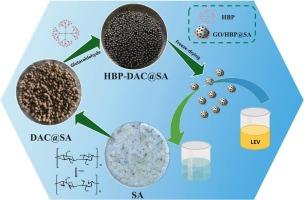The efficient adsorption and removal of levofloxacin by hyperbranched polyamide-aminated dialdehyde cellulose hydrogel
IF 4.2
Q2 CHEMISTRY, MULTIDISCIPLINARY
引用次数: 0
Abstract
Levofloxacin (LEV), a widely used quinolone antibiotic, persists in aquatic environments and is difficult to degrade. Its significant toxicity can exacerbate the spread of antibiotic resistance through environmental transmission, making it a pollutant that urgently requires attention. As a new type of porous adsorbent material, hydrogels offer abundant adsorption sites during the adsorption process, making them widely used in water pollution treatment. In the present work, sodium periodate was used to oxidize cellulose to synthesize easily modified diacetyl cellulose (DAC). Subsequently, hyperbranched polyamides (HBP) containing multiple amine groups were ammoniated and crosslinked with DAC. Hyperbranched ammoniated double aldehyde cellulose hydrogels (HBP-DAC@SA) featuring a three-dimensional porous structure were prepared. The microstructure of HBP-DAC@SA was analyzed to investigate the adsorption performance of HBP-DAC@SA on LEV pollutants. The effects of synthesis temperature, pH, and HBP-DAC dosage on the adsorption properties of LEV were investigated through orthogonal experiments. The adsorption capacity of HBP-DAC@SA for LEV reaches up to 216.72 mg·g−1. The adsorption kinetics and adsorption isotherm data are consistent with the quasi-secondary adsorption model and the Langmuir isothermal adsorption model, respectively. Furthermore, the adsorption capacity of HBP-DAC@SA remained at 80 % of its initial capacity after 14 cycles of adsorption/desorption. HBP-DAC@SA is easily recyclable and exhibits excellent reusability. Consequently, it can serve as an effective adsorbent material for treating LEV pollution.

超支化聚酰胺-胺化双醛纤维素水凝胶对左氧氟沙星的高效吸附和去除
左氧氟沙星(LEV)是一种广泛使用的喹诺酮类抗生素,在水生环境中存在且难以降解。其显著的毒性可以通过环境传播加剧抗生素耐药性的传播,使其成为迫切需要关注的污染物。水凝胶作为一种新型的多孔吸附剂,在吸附过程中提供了丰富的吸附位点,在水污染处理中得到了广泛的应用。本研究以高碘酸钠氧化纤维素合成易改性的二乙酰纤维素(DAC)。随后,含有多个胺基的超支化聚酰胺(HBP)被氨化并与DAC交联。制备了具有三维多孔结构的超支化氨化双醛纤维素水凝胶(HBP-DAC@SA)。分析了HBP-DAC@SA的微观结构,考察了HBP-DAC@SA对LEV污染物的吸附性能。通过正交实验考察了合成温度、pH、HBP-DAC用量对LEV吸附性能的影响。HBP-DAC@SA对LEV的吸附量可达216.72 mg·g−1。吸附动力学和等温线数据分别符合准二次吸附模型和Langmuir等温吸附模型。经过14次循环的吸附/解吸后,HBP-DAC@SA的吸附容量仍保持在初始容量的80%。HBP-DAC@SA易于回收,并具有出色的可重复使用性。因此,它可以作为处理LEV污染的有效吸附材料。
本文章由计算机程序翻译,如有差异,请以英文原文为准。
求助全文
约1分钟内获得全文
求助全文

 求助内容:
求助内容: 应助结果提醒方式:
应助结果提醒方式:


